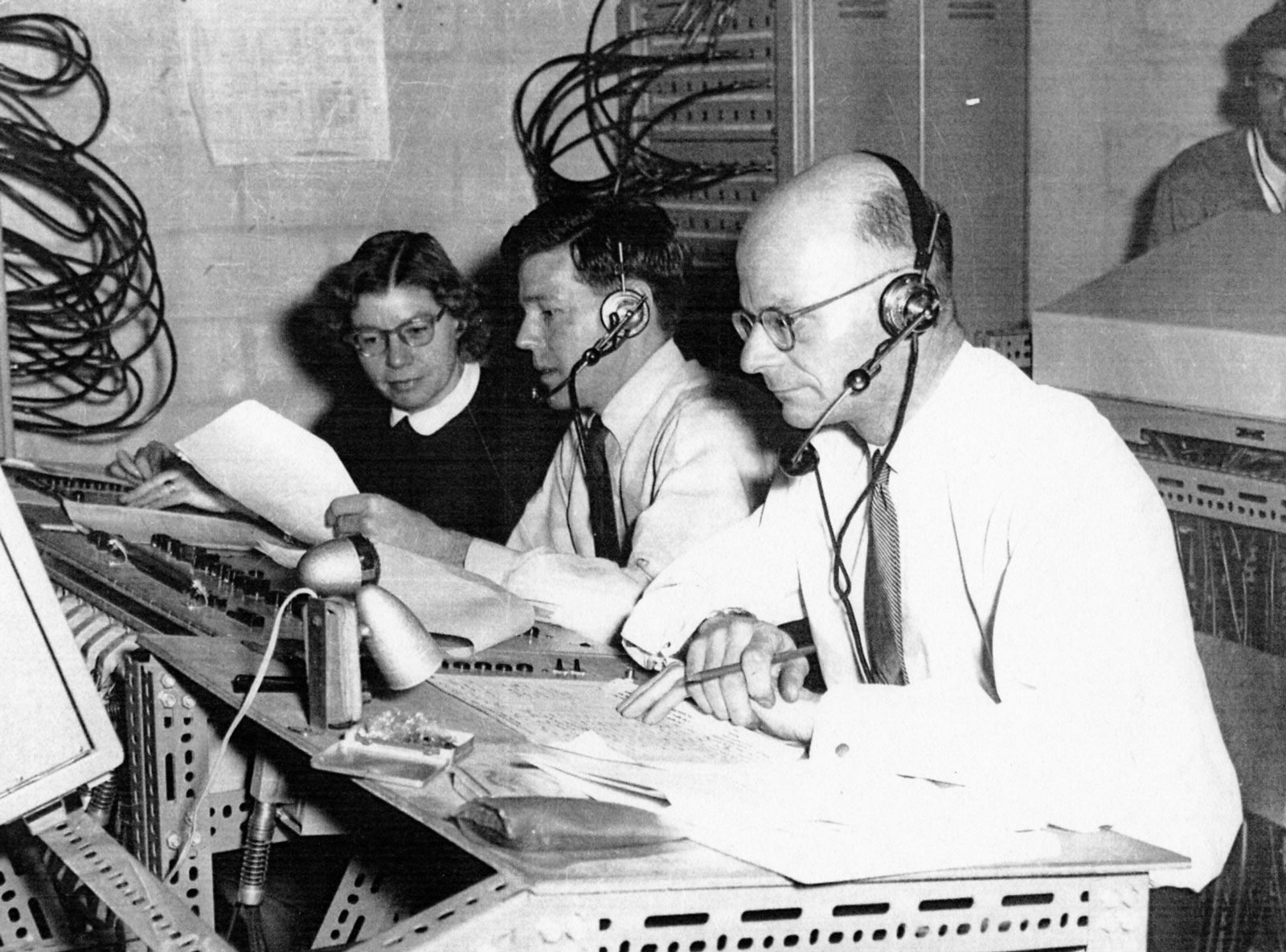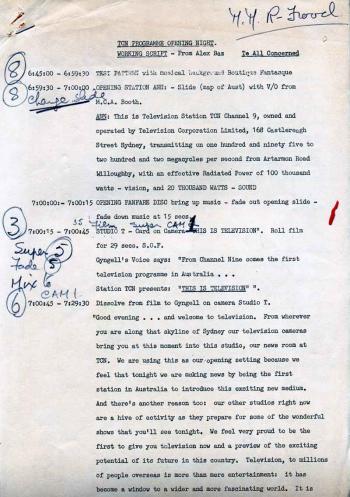This is the first article in a 5-part series on women’s contribution to early Australian television production. For creating the series, Jeannine Baker received the 2022 Oral History Australia Media Award.


This is the first article in a 5-part series on women’s contribution to early Australian television production. For creating the series, Jeannine Baker received the 2022 Oral History Australia Media Award.
Australia’s earliest television broadcasts are usually depicted as all-male affairs, and the ‘first face’ of Australian television is generally understood to be TCN9 Sydney’s Bruce Gyngell, who said 'Welcome to television' on 16 September 1956. But the story is more complicated. Although women are largely invisible in the public record, they were vital to the efficient running of stations, and for getting the first programs to air.
Albert Moran argues that there was no ‘neat, clean beginning’ for Australian television, but a ‘series of beginnings’ as television progressed from experimental transmissions for a select audience in Sydney and Melbourne, to widespread availability in all capital cities and regional areas. An alternative contender for the ‘first face’ of television is Blue Ribbon Westinghouse Chef Zina Chaplin, who conducted a televised cooking demonstration in David Jones’s Sydney store in July 1956.

Left to right: Molly Brownless, producer Mike Ramsden and master controller Max Maxwell in the TCN9 control room on 16 September 1956. Supplied by Molly Brownless.

On the night of 16 September 1956, Molly Brownless was working in TCN9’s central control room and was responsible for ensuring the ‘first’ broadcast was transmitted without a hitch.
Highly qualified in technical aspects of television, Molly had previously worked in BBC Engineering, initially at radio transmitter stations during the Second World War, and from 1946 as a camera operator and vision switcher in the post-war television service at Alexandra Palace in London.
After migrating to Australia, Molly began working at TCN9 while the station was still in the testing phase and was one of the only staff members with practical experience in television engineering. In this excerpt from her oral history interview, Molly explains her role in central control:
Audio: Molly Brownless interviewed by Jeannine Baker, 2019. NFSA title: 1654044.
Image: Molly Brownless, 2019. Photographer: Jeannine Baker. NFSA title: 1654057.
Other women working at TCN9 in the early days were grams operator Helen Chandler, film technicians Joan Filmer and Betty Doughty, and Jean Jenkinson, personal assistant to chief engineer John Briton. Jean’s handwritten transmission log is one of the only pieces of evidence of the opening night broadcast:

Daily programme master log, opening night of TCN9, 16 September 1956. NFSA title: 1482621. Courtesy Nine Network.
Also at TCN9’s Willoughby studio that night was Kay Roberts, director of one of the first television commercials to be broadcast. Roberts began working at Artransa Park Studios in Frenchs Forest when the studio facilities were still being built, and 'gumboots and things were the thing to have because it was knee deep in mud and buildings going up'. From Artransa’s earliest days, staff were engaged in producing commercials in preparation for the launch of television.

Kay Roberts (middle) with cast and crew shooting a Seppelts television commercial at Artransa Park Studios. NFSA title: 355436.
In this excerpt from her oral history interview, Kay talks about performing multiple roles, including continuity, 'script girl' and casting, and her excitement at seeing her commercial go to air:
Audio: Kay Roberts interviewed by Stuart Glover, 1998. NFSA title: 371321
Image: Kay Roberts. Supplied by Di Morrissey
The ABC in Sydney (ABN2) had been preparing for its opening in November 1956 by providing in-house training in television production. Beverley (Bev) Gledhill, then just 16 and working in the education department in radio, jumped at the chance to attend the first training school in November 1955.
The training course was held at St Peter’s Church hall in Forbes Street, Darlinghurst. In this excerpt from her oral history interview, Bev captures the widespread excitement about the new technology, as well as the 'all in' approach to early production:
Bev Gledhill interviewed by Brendan Horgan, 2000. NFSA title: 438318
As Bev recalls, ABN2’s opening broadcast included the first live drama produced for Australian television – The Twelve Pound Look (not The Million Pound Note), based on JM Barrie’s stage play and directed by Paul O’Loughlin at the Arcon, Gore Hill. The costumes were designed by Thelma Afford, an experienced designer for theatre, film, and large public celebrations:

Images: Joan Lord as Lady Sims wearing Thelma Afford’s costume design for The Twelve Pound Look. NFSA title: 460838.
Margo Lee as Kate wearing Thelma Afford’s costume design for The Twelve Pound Look. NFSA title: 460721.
Afford’s designs for the ABC were made by theatrical dressmaker Peggy Henderson, and wardrobe mistresses the Weatherly sisters prepared the costumes for the performance:

The Weatherly sisters, wardrobe mistresses, preparing Thelma Afford’s costumes on the opening night of national television, 5 November 1956. Courtesy Australian Broadcasting Corporation Library Sales.
Floor manager Helen Lockhart and script assistants Ruth Page (pictured below) and Prue Bavin also worked on the ABC launch.

ABC producer Alan Burke and script assistant Ruth Page. NFSA title: 532912. Courtesy Australian Broadcasting Corporation Library Sales.
Prue later recalled the anticipation in the air:

Mungo [MacCallum] was the producer and I was there as his script assistant. The OB Van was parked in Kellett Street. We used a large radio/orchestral training studio above Woolworths as the opening night studio. That’s where the official party was located. Michael Charlton did all the presentation from the same studio. The production team there included Ray Menmuir as the producer and Ruth Page as the script assistant. We were all chewing our fingernails, but the whole thing went off very well.
Val Byth began working at GTV9 Melbourne as secretary to Managing Director Colin Bednall, while the station was still in its testing phase. It was a multifaceted job that included selecting the first booth announcers, assisting with test pattern transmissions, and fielding enquiries from the public about how to operate television sets. As Val explains here, she was even tasked with recording the results for the 1956 Melbourne Olympic Games, which GTV9 filmed as part of its test transmission:
Val Byth interviewed by Brendan Horgan, 2000. NFSA title: 462222.
In 1959 Bev Gledhill, then working at ATN7 Sydney as a producer and director, was head-hunted to join Western Australia’s first television station TVW7. There she joined 2 other significant women in the development of the station: Penny Hoes, an experienced script assistant from London, and Coralie Condon, a theatre producer, actor, composer and television scriptwriter. The 3 women were responsible for selecting TVW7’s on-air talent for the start of broadcasting on 16 October 1959. As one of the few people with television production experience, Gledhill taught 'cameramen, studio hands, everyone, how to do things', and even helped to paint sets.
This film about the launch of TVW7 shows women working in the film department preparing films for the opening night, and the auditioning of performers by producer Coralie Condon, director Bev Gledhill, assistant Penny Hoes and program manager Lloyd Lawson. The team reviewed over 300 acts, including singers, instrumentalists, comedians, actors and a performing dog:
Excerpt from Project Teleview, 1959. NFSA title: 717286. Courtesy Seven Network. All rights reserved. ©
Bev Gledhill was also the director of the opening night’s program. This sequence from Project Teleview shows Gledhill and director’s assistant Penny Hoes in the Studio 2 control room on opening night, giving instructions to the studio crew:
Excerpt from Project Teleview, 1959. NFSA title: 717286. Courtesy Seven Network. All rights reserved. ©
In her interview with Brendan Horgan in 2002, Coralie Condon recalls producing TVW7’s first variety show, Spotlight, on a shoestring budget:
Coralie Condon interviewed by Brendan Horgan, 2002. NFSA title: 576275.
Women continued to be instrumental in production at TVW7 for many years. Coralie went on to produce children’s, women’s and variety programs, including TVW7’s first daytime women’s program Televisit, which she also presented from 1962. She also wrote and produced televised musical comedy The Good Oil in 1962.
Penny Hoes became a producer and director. Other notable women at TVW7 included studio director Jean Hunsley, presenters Carolyn Noble (later Tannock) and Audrey Barnaby (later Long), and Marion Greiling (later Leyer), who began as a production assistant in 1960 and rose to become a producer, director and production manager.
This is the first part of a 5-part series, The Women Who Made Australian Television, written and curated by Dr Jeannine Baker, media historian and Honorary Fellow in the Faculty of Arts, Social Sciences and Humanities, University of Wollongong.
This series was made possible with the generous support of the Media Studies Commission of FIAT/IFTA, the National Film and Sound Archive of Australia, Seven Network, Nine Network, Network 10, and the Australian Broadcasting Corporation – Library Sales.
Read The Women Who Made Australian Television Part 2 – Behind the Scenes: Women Technicians, Part 3 - Calling the Shots, Part 4 – Women's and Children's Programs and Part 5 – Rosemary Eather.
Main image: Crowd watching test TV transmission in Townsville, 1962. NFSA title: 809738.
Image with quote: Script assistant Prue Bavin with (L-R) Gordon Waterhouse, Lloyd Berndt, Ken Middleton and Mungo MacCallum inside an OB van during a training exercise, 1956. Courtesy Australian Broadcasting Corporation Library Sales.
Hogan, Christine. Look at Me! Behind the Scenes of Australian TV with the Women Who Made It. ABC Books, 2006.
Moran, Albert. ‘Some beginnings for Australian television: the first Governor-General’, Continuum: The Australian Journal of Media & Culture volume 4, no 2, 1991.
Ashton, Richard. ‘TVW Opening’, watvhistory.com
The National Film and Sound Archive of Australia acknowledges Australia’s Aboriginal and Torres Strait Islander peoples as the Traditional Custodians of the land on which we work and live and gives respect to their Elders both past and present.